Physical Address
304 North Cardinal St.
Dorchester Center, MA 02124
Physical Address
304 North Cardinal St.
Dorchester Center, MA 02124
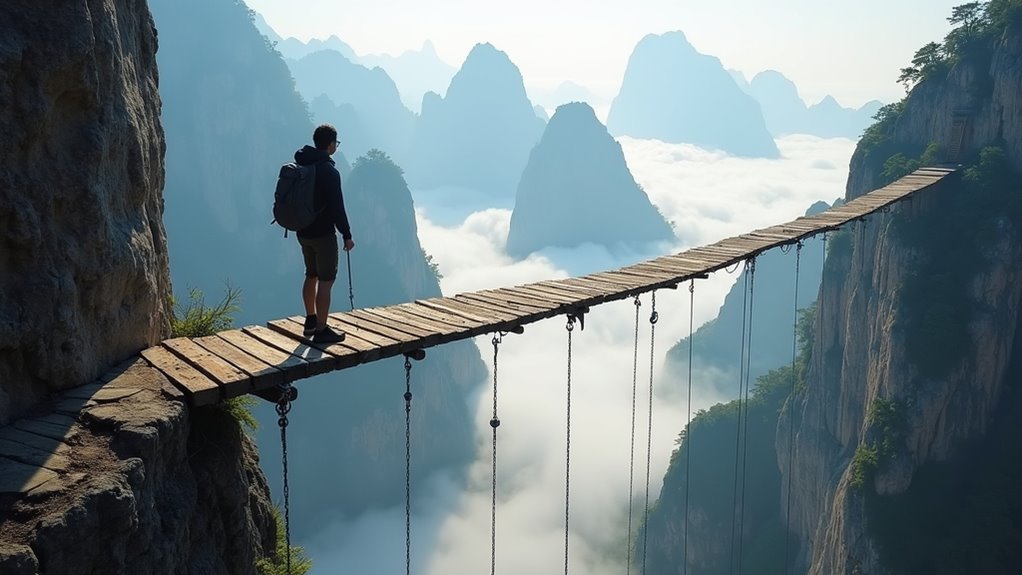
Hike these deadly trails at your own risk: 12 heart-stopping adventures where one wrong step could be your last.
If you’ve ever dreamed of testing your limits on the world’s most challenging trails, you’ll need to know what you’re getting into first. From the death-defying Plank Walk of Mount Huashan to the treacherous slopes of Annapurna, these infamous hikes aren’t just about stunning views – they’re about survival. While thousands tackle these trails each year, not everyone makes it back. Before you strap on your hiking boots, let’s explore what makes these paths the planet’s most feared adventures.
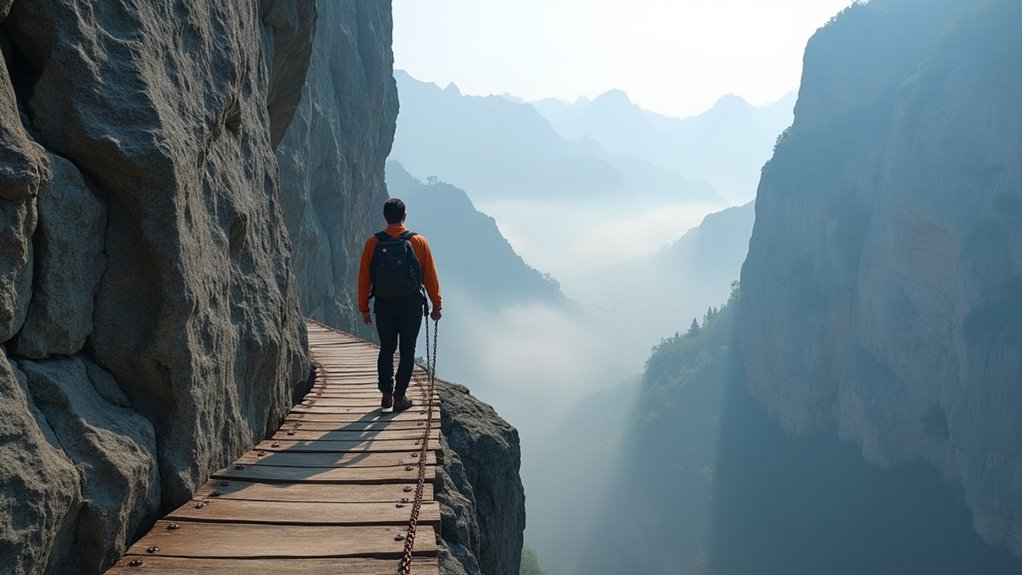
While Mount Hua serves as one of China’s Five Great Mountains, it’s the heart-stopping Plank Walk that has earned its reputation as one of the world’s most dangerous hikes.
Located 2,155 meters high on the mountain’s South Peak, this 130-meter wooden path clings to a sheer rock face without guardrails.
You’ll need to harness up for this 20-minute journey that was originally built by a Taoist priest over 700 years ago.
Though modern safety features like iron chains and metal supports have been added, a single misstep could be fatal.
The path, situated about 120 kilometers east of Xi’an, draws thousands of thrill-seekers annually.
Before attempting this mentally and physically challenging trek, you might want to reflect on the massive crowds and weather conditions that could affect your experience. July brings heavy rainfall and the highest temperatures of the year, making the planks particularly treacherous.
From China’s precarious planks to America’s high-altitude challenges, Colorado’s Capitol Peak presents a different kind of terror at 14,136 feet.
You’ll face the infamous Knife Edge, a 100-foot ridgeline with 1,000-foot drops on both sides, where one misstep could be fatal. The standard route demands technical climbing skills and careful navigation through loose rock and exposed terrain. Many climbers have turned back after seeing the exposure at this notorious section.
The Knife Edge forces you to balance between life and death, testing your nerve across 100 feet of terrifying exposure.
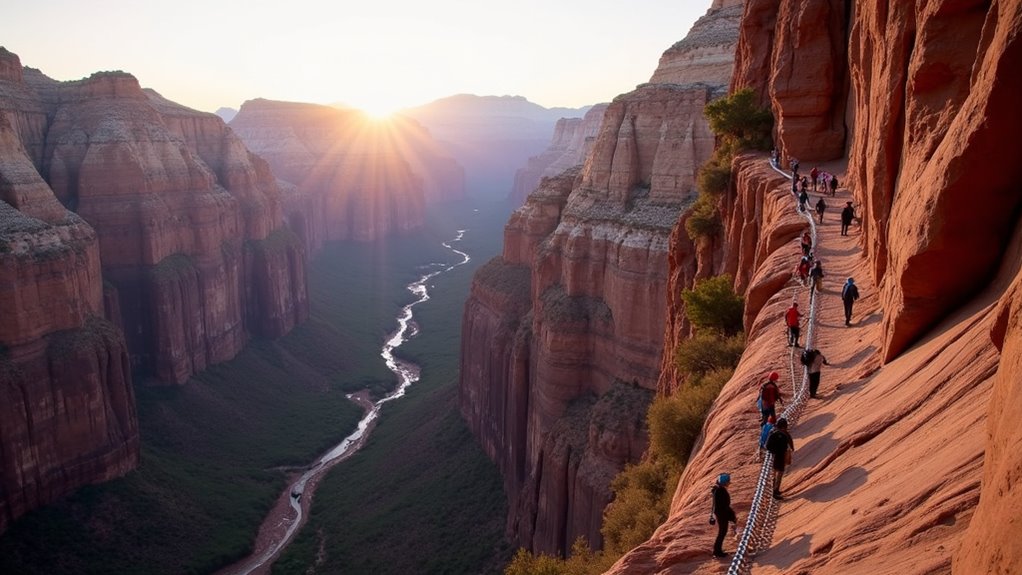
As you ascend the legendary Angels Landing trail in Utah’s Zion National Park, you’ll discover why its anchored chains have become a lifeline for hikers braving the 5,790-foot summit. Essential tips for a safe and enjoyable camping adventure can help make your hike more comfortable and secure.
The strenuous 5-mile round-trip journey demands both physical stamina and mental fortitude, especially along narrow sections less than three feet wide. With spring and fall offering the most favorable hiking conditions, careful planning of your visit is essential.
You’ll need a permit to tackle this challenging route, which has claimed at least 16 lives. The path from Scout Lookout to the summit presents the most formidable challenge, where chains guide you through exposed cliff edges.
Walter’s Wiggles, a series of tight switchbacks, will test your endurance before you reach the top.
Don’t attempt this hike if you fear heights or aren’t physically prepared – instead, consider stopping at Scout Lookout for equally impressive views.
Nestled in Nepal’s majestic Himalayas, the Annapurna Circuit challenges even seasoned trekkers with its demanding 160-210 km trail system. You’ll face treacherous conditions while ascending to the breathtaking Thorong La Pass at 5,416 meters, where thin air and extreme weather can turn your adventure into a survival test. The trail winds through the pristine Annapurna Conservation Area, home to numerous endangered species and stunning natural wonders.
While trekkers aged 16 to 70 have conquered this circuit, don’t underestimate its risks. The spectacular Himalayan views come at a price that demands your utmost respect and preparation.
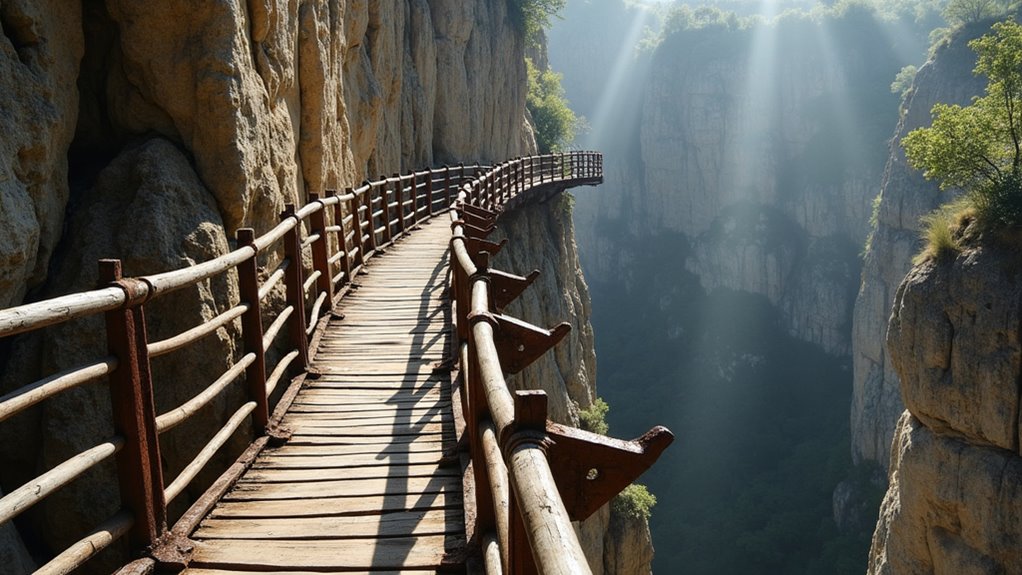
After multiple fatalities in 1999-2000, authorities closed the deteriorating walkway.
Originally constructed between 1901 and 1905, the pathway served as crucial access for hydroelectric plant workers.
You’ll be relieved to know that since its 2015 reopening, the path features modern safety measures including secure railings and reinforced boardwalks.
Today, you’ll need to book in advance as daily visitors are limited to 1,100 people.
Advance booking required – visitor numbers capped at 1,100 per day to maintain safety and preserve this stunning experience.
While you’re still walking 300 feet above the gorge floor, you’re now part of a safer experience that attracts nearly 300,000 visitors annually to this spectacular piece of Spanish engineering heritage.
Standing tall in Yosemite National Park, Half Dome‘s notorious cable route challenges even experienced hikers with its intimidating 17-mile round trip and punishing 5,457-foot elevation gain.
You’ll need a permit and proper preparation to tackle this formidable ascent to 8,800 feet above sea level, where weather conditions can change rapidly. Protective gloves are essential equipment to prevent painful hand abrasions from gripping the steel cables.
Don’t attempt this hike without checking weather conditions, bringing appropriate gear, and ensuring you’re physically prepared.
The remote location means emergency response could be delayed if something goes wrong.
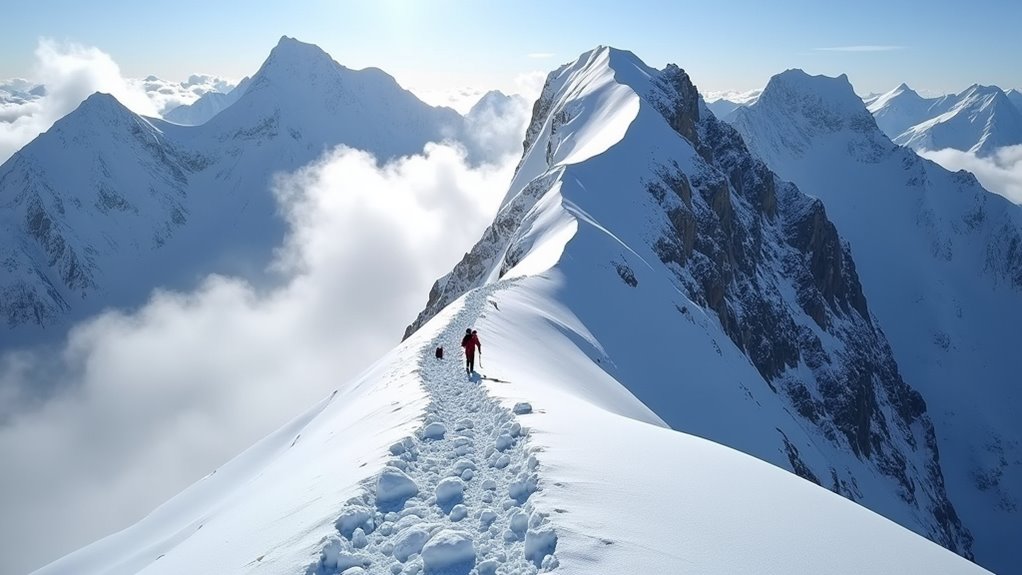
Towering at an intimidating 5,000 meters above sea level, K2 Base Camp trek pushes adventurers to their absolute limits through a grueling 160-kilometer journey across treacherous glacial terrain.
You’ll face dramatic temperature swings, from scorching 30°C days to sub-zero nights, while battling unpredictable storms that can strike without warning. The trek requires constant vigilance with frequent crevasse hazards making it essential to stay close to guides.
Over 12-14 days, you’ll trek 6-8 hours daily through rugged paths and glacial moraines, gaining more than 10,000 meters in total elevation.
While the standard route doesn’t require technical climbing skills, you’ll need exceptional fitness and proper acclimatization to combat the brutal altitude effects.
Don’t attempt this trek without an experienced guide and thorough preparation – the combination of harsh weather, challenging terrain, and extreme altitude makes this one of mountaineering’s most demanding adventures.
China’s legendary Tiger Leaping Gorge challenges hikers with a 26-kilometer trek through one of Earth’s deepest canyons, where sheer cliffs plunge 13,000 feet to the churning Jinsha River below.
You’ll face the notorious “28 Bends,” a grueling series of switchbacks that climb from 6,500 to 8,500 feet, testing your endurance and resolve. With only 3/4 the oxygen available compared to sea level, every step becomes a test of willpower.
The steep descent to Leaping Gorge Rock demands careful footing and steady nerves – it’s not for the faint-hearted or those with knee problems.
Pack appropriate gear and plan for a 2-3 day journey through this awe-inspiring landscape.
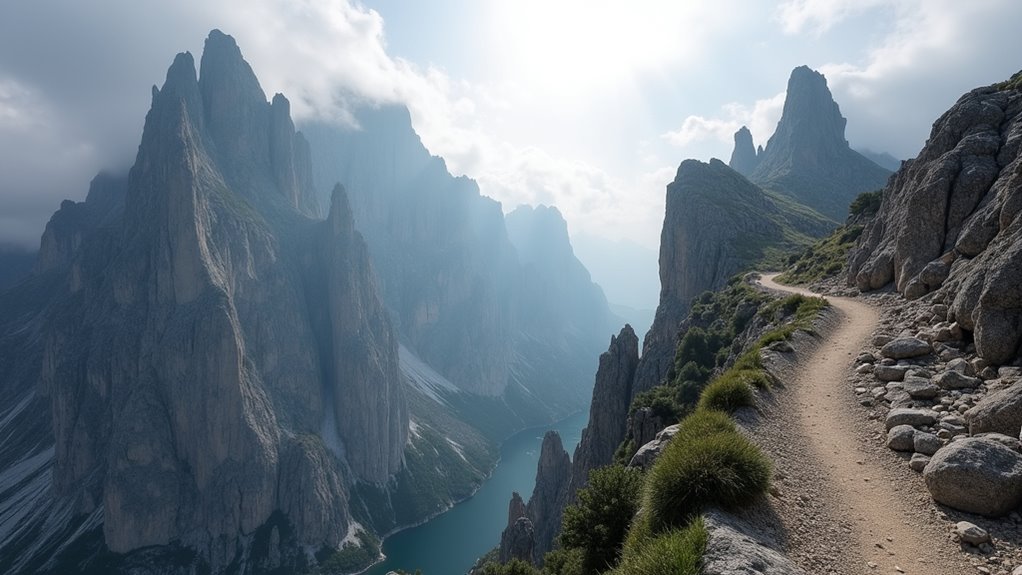
While Tiger Leaping Gorge tests your fear of heights, France’s legendary GR20 in Corsica pushes your entire body to its limits.
You’ll face 180 kilometers of Europe’s toughest trail, conquering 10,000 meters of elevation gain across rugged, technical terrain.
Don’t underestimate this beast – you’ll need 10-16 days to navigate its challenging scrambles, exposed ridges, and scree slopes. Traditional hikers often complete the journey in sixteen daily stages, allowing time to rest at mountain refuges each evening. The north section delivers the most technical challenges, while the south offers moderate forest trails.
Demanding scrambles and precarious ridges await in the north, while gentler forest paths wind through the southern section.
You’ll climb to Monte Cinto at 2,706 meters, battling unpredictable weather and sudden storms along the way.
If you’re attempting the GR20, plan your trek between June and September, book refuges in advance, and pack reliable navigation tools.
You’ll need solid hiking experience, sturdy gear, and exceptional fitness to tackle this untamed trail safely.
Located in Malaysian Borneo, Mount Kinabalu‘s seemingly manageable 4,095-meter height belies its deadly nature. With four fatalities in under a year, including two elderly climbers who perished near the summit, this mountain demands your utmost respect and preparation.
The combination of rapid weather changes, steep terrain, and high altitude creates a treacherous environment that can quickly turn fatal. The most recent tragedy involved a British climber who died from extreme cold exposure while inadequately dressed for summit conditions. Cold-weather camping survival strategies are essential for tackling this dangerous mountain.
You’ll face sudden temperature drops that can lead to deadly hypothermia within hours. Your body will battle against thin air while maneuvering through technical rock sections. You’re at the mercy of unexpected rockfalls and dangerously slippery surfaces. Your stamina will be tested by sustained exertion at high elevation.
Don’t let the mountain’s popularity fool you. Without proper preparation and awareness of your physical limits, you could become another statistic in Kinabalu’s growing list of casualties.
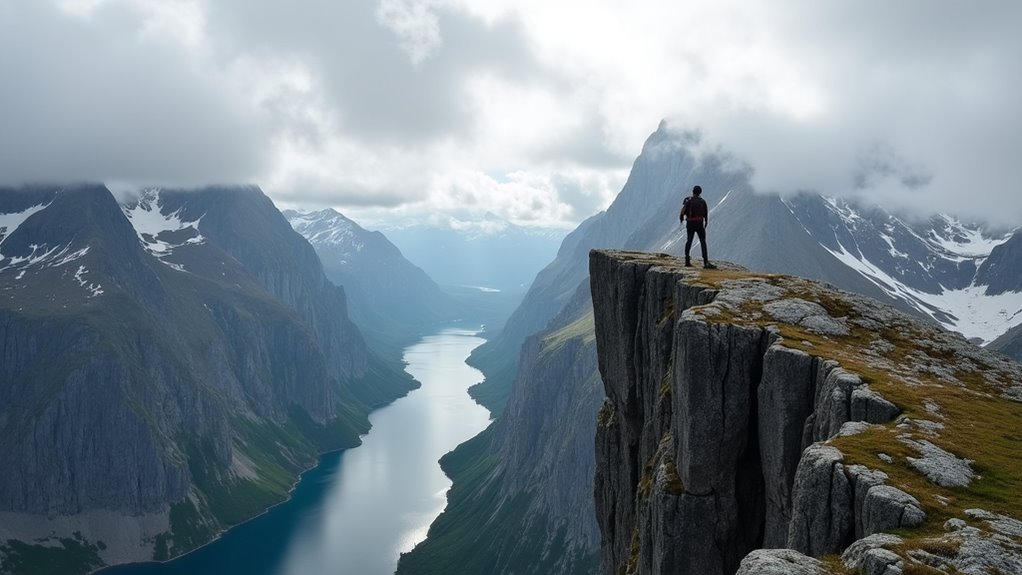
Along Norway’s rugged western coast, the Romsdalseggen Ridge serves as one of Europe’s most formidable day hikes, challenging adventurers with its razor-thin paths and vertigo-inducing drops. Common camping mistakes can make this hike even more treacherous.
You’ll face a demanding 10-kilometer trek that climbs nearly 1,000 meters through technical terrain. The route requires scrambling across rocky sections while maneuvering around exposed cliff edges, often using chains for support. The trek typically takes 8.5 hours to complete.
At its peak, you’ll reach Mjølvafjellet at 1,222 meters, where dramatic panoramas await—if you dare to look down.
Standing atop Mjølvafjellet’s windswept summit, the world drops away beneath your feet, offering breathtaking vistas for those brave enough to peek.
Don’t attempt this expert-level hike without proper preparation. You’ll need alpine hiking experience, sturdy footwear, and weather-appropriate gear.
While you can access the trail via the Romsdalseggen shuttle bus from Åndalsnes, remember that conditions can change rapidly. For a less intimidating experience, consider taking the alternative Høgnosa trail.
Rising to a staggering 6,961 meters in Argentina’s Andes Mountains, Aconcagua serves as South America’s deadliest peak and the highest mountain outside Asia.
While you won’t need technical climbing skills for the standard routes, don’t let this fool you. The mountain’s extreme altitude, unpredictable weather, and harsh conditions make it a formidable challenge that claims lives every season.
With an average of three deaths per year, Aconcagua has earned its grim nickname “Mountain of Death.”
Before attempting Aconcagua, verify you’ve got extensive high-altitude experience and are prepared for its wild extremes.
These trails will both terrify and inspire you, offering heart-stopping exposure alongside unmatched natural beauty. While you’ll find yourself testing your limits on knife-edge ridges and weather-beaten paths, remember that proper preparation is your lifeline. Don’t let the thrill override safety – research thoroughly, check conditions, and know your capabilities. These world’s scariest hikes aren’t just adventures; they’re lessons in respect for nature’s raw power.